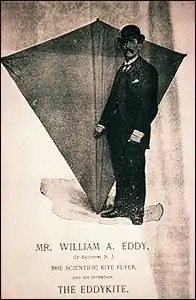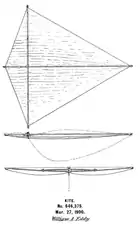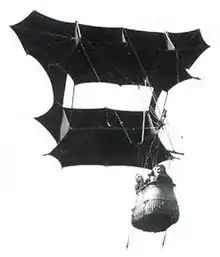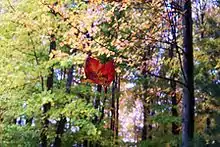Kite applications
The kite can be used for many applications. Air kites, water kites, bi-media kites, fluid kites, gas kites, kytoons, paravanes, soil kites, solid kites, and plasma kites have niche applications that are furthering the interests of humans in both peace and conflict. Non-human-made kites have applications; some spiders make use of kiting.
.jpg.webp)

Aerial photography
 William Abner Eddy patented a kite. He used kites for aerial photography (KAP).
William Abner Eddy patented a kite. He used kites for aerial photography (KAP). US646375 Willian A. Eddy kite patent image.
US646375 Willian A. Eddy kite patent image. Photo of the ruins of the 1906 San Francisco earthquake by George Lawrence of Chicago. Photographed using a kite system to loft a panoramic camera.
Photo of the ruins of the 1906 San Francisco earthquake by George Lawrence of Chicago. Photographed using a kite system to loft a panoramic camera.
William A. Eddy of Eddy-kite fame lifted cameras to take photographs of cities and landscapes. Today KAP is the hobby of many enthusiasts, is a tool for surveying land and animals, and a mode for artistic expression. Professor Charles Benton illustrates how KAP can grow in one's life. Scott Haefner has one of the most extensive collection of KAP photographs; he shares his technology. San Francisco. Those who do KAP are called kapers KAP.
Teaching
The kite is frequently the vehicle for teaching aerodynamics, mathematics, art, history, culture, materials, cooperation, physical education, and problem solving.[1][2][3][4][5]
Transport
 George dickens's contribution being illustrated.
George dickens's contribution being illustrated. Painting of kite tugging wheeled vehicle.
Painting of kite tugging wheeled vehicle. Getting around in a kite buggy.
Getting around in a kite buggy. Transport people up into the sky with man-lifting kites for observation, entertainment, photography, recreation.
Transport people up into the sky with man-lifting kites for observation, entertainment, photography, recreation. Man-lifter kite designed by Samuel Franklin Cody (1867–1913). As war kite observation of enemy, raising antenna.
Man-lifter kite designed by Samuel Franklin Cody (1867–1913). As war kite observation of enemy, raising antenna.
Long-distance travel across land,[6] ice, and sea started centuries ago, but today significant tasks of moving people and goods from point A to point B are occurring; this is so in great part from the advances in kites and kite systems designs and technology, better understanding of winds, and use of computers and GPS. In 1889 kite sailing was carefully instructed via controlling large kite systems towing boats: Aerial Apparatus
Free-flight cross-country hang gliding kites both in the hang glider style and the paraglider style are permitting trips of hundreds of miles; records are recorded by the FAI. George Pocock (inventor) was an early pioneer in kites for transportation. NASA continues to explore free-flying kites for delivering goods to earth surface and non-earth planet surfaces, including Mars.[7] There are several projects for using very large kites to sail cargo ships currently underway: KiteSail and KiteShip along with a series of patents and improvements in control of large ship-carried kite systems aim to save significant amounts of fuel.[8][9] [10][11] Kiting one's kayak is getting a significant following A. Kinsman – kite kayaking tutorial..
Kite yachting may have started with Benjamin Franklin's pond pull.[12] English Channel crossing.
Anne Quemere has crossed the Atlantic Ocean solo using power kites. And on 4 November 2008, she started her bid to cross the Pacific Ocean under power kites as sailing power to pull her in her small boat called Oceankite.[13]
Cargo
The German company SkySails has developed ship-pulling kites as a supplemental power source for cargo ships, first tested in January 2008[14] on the ship MS Beluga Skysails. Trials on this 55 m ship have shown that, in favorable winds, the kite increases fuel-efficiency by up to 30%. This system is planned to be in full commercial production late 2008.[15] Kites are also available as an auxiliary sail or emergency spinnaker for sailing boats. Self-launching Parafoil kites are attached to the mast.
MS Beluga Skysails is the world's first commercial container cargo ship which is partially powered by a giant computer-controlled kite (160 m². or 1,722 sq ft.). The kite could reduce fuel consumption by 20%. It was launched 17 December 2007 and is set to leave the northern German port of Bremerhaven to Guanta, Venezuela at 1700 local time (1600 GMT), 22 January 2008. Stephan Wrage, managing director of SkySails GmbH announced: "During the next few months we will finally be able to prove that our technology works in practice and significantly reduces fuel consumption and emissions." Verena Frank, project manager at Beluga Shipping GmbH, SkySails GmbH's partner further stated that "the project's core concept was using wind energy as auxiliary propulsion power and using wind as a free of charge energy".[16]
Using kites to reduce the work done by an engine in propelling a cargo ship is an idea that is gaining traction as a result of increasing fuel prices and environmental concerns. For example, SkySails GmbH have developed technology that they estimate can reduce fuel usage by 10–35% per day on average.[17][18] A trial on board the MS Beluga resulted in fuel savings estimated to be worth £800 per day.[19] This particular technology earned the company a sustainable shipping award for "Environmental Technology of the Year" in 2011.[20]
The idea of using wind power for ships is, of course, nothing new. However, using large kites has several significant advantages over traditional sails:
- A well designed kite can generate up to 25 times more power per unit area than a sail[18] for several reasons:
- Kites can be flown high above the ship, taking advantage of stronger, steadier winds. For example, a kite flying on a 200 m line will have twice as much wind energy available to it as a kite on a 10 m line.[21]
- A kite can be maneuvered to optimise its position in the airflow.
- A kite's shape is designed to both block air in the manner of a traditional sail and to function like an aerofoil, resulting in combined forces of lift and drag pulling the boat through the water.[22]
- All that is needed to operate the kite is a winch and a storage area located towards the front of the ship, which can be fitted with little modification and at low cost. A sail, however, requires a mast to be installed, which is much more expensive and reduces the cargo area on the deck of the ship.[17]
- In addition, masts and sails can act as very large levers, effectively destabilising the ship in severe conditions.
Kites have been proposed for use in logging, to lift logs out of areas without roads.[23]
Advertising / promotional
Kites can also be used as light-effect carrier, e.g., by carrying light-sticks or battery-powered light effects. Promotional kites: Companies buy large quantities of kites that feature their advertisement. Messages are sometimes displayed by lighting systems that are built into the kite system.
Many kite stores fly kites regularly so that people will see the kites; one of the final purposes is for the store to profit from the flying of the kites.[24] Kites are necessary to increase sales of kites.
Entertainment and recreation
 Resting during recreational kiting.
Resting during recreational kiting. Recreationally meeting the challenge of designing something attractive, fun, interesting: hobby designer Frank Vincentz.
Recreationally meeting the challenge of designing something attractive, fun, interesting: hobby designer Frank Vincentz. Frank Vincentz plays soccer in the sky for fun.
Frank Vincentz plays soccer in the sky for fun. Winter playing on the ice.
Winter playing on the ice.
- Hobby
- Group festivities
- Art
- Meditation
- Sport
Extreme sports
Kite boarding, kite surfing, kite buggying, kite buggy jumping, kite landboarding, freestyle kite landboarding, snow kiting or snowkiting, downhill speed kiting, hang gliding, and kite high jumping are among the extreme kite sports wherein competitions are held.
Competitive stunt-kiting
Peter Powell's development and promotion of two-line stunt kites or sport kites help to move stunt kiting into a popular activity as well as a competitive sport. Also, the parafoil stunt kites feed the same sporting activity. Events for kites of more than two control lines are common. The four-line Revolution kite has been setting new standards in precision flying. Informal field competition and formal sport competition support a stunt-kite industry; seemingly endless refinements to the kite wing and kite line along with accessories continue unabated.[25][26]
Kite fighting
A kite has two essential parts: wing and tether line. In kite fighting, the kite line plays a huge part in the activity. Sport kite fighting is perhaps 2000 years old; participation worldwide is high.[27] North American Kite Fighter Association (NAFKA) Trawl-board and paravane innovator
 Kite festival, Kanagawa, Japan. May Kite festival, first attempt to fly 40' x 40' handmade kite. On the Sagami River. Teaming at a festival.
Kite festival, Kanagawa, Japan. May Kite festival, first attempt to fly 40' x 40' handmade kite. On the Sagami River. Teaming at a festival. Kite festival in Heiligenhaus, Germany, 15./16. Sep. 2007 Source: self-made Date: created 16. Sep 2007 Author: Frank Vincentz
Kite festival in Heiligenhaus, Germany, 15./16. Sep. 2007 Source: self-made Date: created 16. Sep 2007 Author: Frank Vincentz.jpg.webp) Bali Kite Festival (Padang Galak Beach)
Bali Kite Festival (Padang Galak Beach) Professional kite flyer and aerial ballet master Ray Bethell performing at the Berkeley Kite Festival. This photo shows Ray flying three stunt kites simultaneously.
Professional kite flyer and aerial ballet master Ray Bethell performing at the Berkeley Kite Festival. This photo shows Ray flying three stunt kites simultaneously. Kite festival at La Tremblade beach, Charente-Maritime (17), France. Festival de cerfs-volants sur la plage de la Tremblade en 2001.
Kite festival at La Tremblade beach, Charente-Maritime (17), France. Festival de cerfs-volants sur la plage de la Tremblade en 2001.
Frequently kites are used to entertain observers[28] Some kiters get entertain themselves, but others enjoy entertaining the public or members of an organized gathering. This sector of application is part of recreational uses, but sometimes part of commercial uses.
Decoration
 Train station decorates waiting platform.
Train station decorates waiting platform. Roloplan and stuffed animals in the museum of Margarete Steiff company. Giengen Germany.
Roloplan and stuffed animals in the museum of Margarete Steiff company. Giengen Germany.
Kites stilled are hung decoratively in rooms of homes and businesses to set the tone of a home or selling environment.[29]
Fishing
Recreational, sport, and subsistence
 Tow-line depressing water kite
Tow-line depressing water kite Water kite for fishing
Water kite for fishing Water kite (paravane) as lure for fishing.
Water kite (paravane) as lure for fishing.
There are several ways kites are used in recreational and sport fishing. Lofting drop lines is one, but things don't stop there. Net-spreading underwater kites, soil kites (kiting anchors), kiting bait, control-kite trolling of bait, recreational kiting during fishing sessions, aerial photography of fishing environment using kites, and out and back cycles of trolling bait using a kite. Recreational fishing, commercial fishing, and scientific and military uses of depressors of tow lines use water kiting to accomplish the effects wanted. The Use of Kites for Fishing—George Webster wrote comprehensively on kite fishing. Jetty/Pier Fishing.; _ Paravanes for Sportfishing. A plan view of a Solomon islander's leaf fishing kite is shown in a photograph held by the Pitt-Rivers Museum is viewable at Natural History Magazine online; Pick from the Past, Natural History, April 1957: "Go Fly a Kite".[30]
In Kite Fishing by the Salt-Water Natives of Mala or Malaita Island, British Solomon Islands T. W. Edge-Partington, leaf kites are described. The sago palm or ivory nut tree has leaves from which natives of Mala or Malaita Island made kites for fishing. [31][32]
Commercial
 Water kite
Water kite
Net-spreading underwater kites and kite vanes aid the control of large fishing nets. Remotely controllable paravane Robert A. Kirby et al.
Military
Kites have been used for military uses in the past for signaling, for delivery of munitions, for free-flight kiting payloads from aircraft to ground positions, for kiting troops to points where they could parachute to destinations, for underwater kiting via paravanes to perform various underwater duties, for lifting payloads from one point to another, for raising rescue signals from rafts or stressed areas, for raising communications antenna, and for observation by lifting an observer above the field of battle, and by using kite aerial photography. Barrage kites have been used in both open frame kites and kytoon types to defend against enemy aircraft.[33]
Kim Yu-Sin (or Kim Yushin), a Korean general, in 637 C.E. rallied his troops to defeat rebels by kite lofting a burning ball.[34] Kites were also used by Admiral Yi of the Joseon (1392–1910) Dynasty of Korea. During the Japanese invasions of Korea (1592–1598), Admiral Yi commanded his navy with kites. His kites had specific markings directing his fleet to perform his order. Admiral Yi was said to have over 300 such kites. The war eventually resulted in a Chinese and Korean victory; the kites played a minor role in the war's conclusion.
In more modern times the British navy also used kites to haul human lookouts high into the air to see over the horizon and possibly the enemy ships, for example with the kite developed by Samuel Franklin Cody.[35] Barrage kites were used to protect shipping during the Second World War.[36][37] Kites and kytoons were used for lofting communications antenna.[38] Submarines lofted observers in rotary kites.[39] The Rogallo parawing kite[40] and the Jalbert parafoil kite were used for governable parachutes (free-flying kites) to deliver troops and supplies.[41]
Science
 Lighter-than-water kite as tailing buoy
Lighter-than-water kite as tailing buoy.jpg.webp) Kite of the US Weather Bureau carrying meteorograph c. 1910
Kite of the US Weather Bureau carrying meteorograph c. 1910
Kites have been used for scientific purposes, such as Benjamin Franklin's famous experiment proving that lightning is electricity. Kites were the precursors to aircraft, and were instrumental in the development of early flying craft. Alexander Graham Bell experimented with very large man-lifting kites, as did the Wright brothers and Lawrence Hargrave. Kites had an historical role in lifting scientific instruments to measure atmospheric conditions for weather forecasting. Francis Ronalds and William Radcliffe Birt described a very stable kite at Kew Observatory as early as 1847 that was trialled for the purpose of supporting self-registering meteorological instruments at height.[42]
Collecting kited spiders with kited nets: Kites are used to take samples of upper air and to collect things found in the upper air. The spiders that kite to disperse (so-called ballooning spiders) have been found in nets raised to upper air for collecting;[43] the method is noted carefully in Spider Ballooning: Development and Evaluation of Field Trapping Methods (Araneae)[44] Balloon kite of the so-called ballooning spiderlings; the spiders' kite is not a balloon.
Testing
 Wright kite with aim to get a powered aircraft.
Wright kite with aim to get a powered aircraft. Early quad-line steerable kite by Wright Brothers as they aim for powered flight.
Early quad-line steerable kite by Wright Brothers as they aim for powered flight.
Kites were the precursors to aircraft, and were instrumental in the development of early flying craft. Alexander Graham Bell experimented with very large man-lifting kites, as did the Wright brothers and Lawrence Hargrave.
Conductor carried up by a kite in the sky can lead to a high voltage shock, which can endanger people and equipment.
Industrial
Lifting tree logs from logging fields:KITE LOGGING W. H. ROCK
Energy generation
 Kite lofts wind-driven rotating wings
Kite lofts wind-driven rotating wings More rotation.
More rotation.
Both air and hydro kites are used to generate electricity; the kite is set in the stream of air or water; various schemes are used to extract some of the stream's energy for converting that energy to electricity.
A major research and development project called Makani Power, based in California and funded by Google.org, is investigating the use of kites in harnessing high altitude wind currents to generate electricity.[45]
Tidal kites operate underwater, using the tidal stream's greater mass to generate far more electricity than available in wind-borne environments.[46]
Video links for generating electricity by using kites:
- Over 700 kite-energy videos within the AWES industry are collected and open for free view to the public through the AWES Museum.
- Back and forth taking kite generates electricity:.[47]
- MagGenn (Magnus-effect kite wind generator): a Magnus-effect rotating kite electricity generation system: Magenn Power, Inc.;
- NTS GmbH is German company developing X-Wind technology. This technology assembles three existing technologies into X-Wind Plant : Kites, track system and servo motor to steer the kites.[48]
- KiteGen (kite generator). Italian company is working on several methods of generating electricity from kite systems. One key method is the "stem" system.High altitude wind power: an era of abundance?
- Makani Power's 10 kW test platform autonomously generating power:.[49]
Radio aerials and light beacons
Kites can be used for radio purposes, by kites carrying antennas for MF, LF or VLF-transmitters. This method was used for the reception station of the first transatlantic transmission by Marconi. Captive balloons may be more convenient for such experiments, because kite carried antennas require a lot of wind, which may be not always possible with heavy equipment and a ground conductor. It must be taken into account during experiments, that a conductor carried by a kite can lead to a high voltage toward ground, which can endanger people and equipment, if suitable precautions (grounding through resistors or a parallel resonant-circuit tuned to transmission frequency) are not taken.
 Antenna raising in 1915. The kite balloon ship HMS CANNING anchored off Salonika with kite balloon aloft, November 1915.
Antenna raising in 1915. The kite balloon ship HMS CANNING anchored off Salonika with kite balloon aloft, November 1915. Kytoon equipped ship. US Navy photo. A kite balloon has been deployed from the USS Arizona. The kite balloon has a two-man crew.
Kytoon equipped ship. US Navy photo. A kite balloon has been deployed from the USS Arizona. The kite balloon has a two-man crew.
Kites can be used to carry light effects such as lightsticks or battery powered lights.
In nature

There are natural kites that play a part in shaping what happens on earth. Some leaves kite to relieve wind pressures, pump fluids, and to disconnect annually to fertilize the soils. Poet Pablo Rosenblueth expressed his understanding that children see leaves as kites. Poet Marvin Bell recognized leaves are kites in his Nightworks: Poems 1962–2000. The leaf wafts in the wind held by the tethered leaf stem; when it is fall time, the leaf stem has a de-mooring disconnect process; the wind then easily interacts with the leaf to cause it to fly off the trees and into a gliding fall to the ground.[50] There is a following of kite makers that bridle leaves to fly them again as kites.[51][52][53]
Spiders
Billions of spiders use kiting to travel, disperse or to build bridge lines for their webs. Spiders hanging in the moving air on their silks are deflected to various points where they make anchor points for web building.[54][55][56][57][58][59][60][61][62] Carol Frost, biology researcher of the University of Alberta, Canada, observed kiting in spiderlings.[63]
See also
References
- "Kites for Education". Chinakite.com. Retrieved 3 January 2012.
- "Kites Go To School". Kitehistory.com. Retrieved 3 January 2012.
- "LESSON PLAN: Oh, Go Fly a Kite!". Intime.uni.edu. Archived from the original on 8 February 2012. Retrieved 3 January 2012.
- Kites for School
- "Kites in the Classroom". Classroom.kitingusa.com. Retrieved 3 January 2012.
- "The Aeropleustic Art or Navigation in the Air by the use of Kites, or Buoyant Sails". Special.lib.gla.ac.uk. Archived from the original on 9 December 2006. Retrieved 3 January 2012.
- "Griffon: A Man-Portable Hybrid UGV/UAV" (PDF). Retrieved 3 January 2012.
- "Apparatus and method for aerodynamic wing David A. Culp". Retrieved 3 January 2012.
- "Using Kites to Pull Cargo Ships Across the Seas by Jorge Chapa". Inhabitat.com. 20 March 2008. Retrieved 3 January 2012.
- Homepage-Baukasten (24 October 2011). "Beluga Group". Beluga Group. Archived from the original on 1 December 2008. Retrieved 3 January 2012.
- "MegaFly Summary. Very large Jalbert parafoil kite for governed-free-flight delivery of payloads". Archived from the original on 6 August 2007.
- [email protected]. "Kite History. Recant of Benjamin Franklin's using a traction kite to be pulled across a pond". Plumcreekmarketing.com. Archived from the original on 4 October 2011. Retrieved 3 January 2012.
- "Pacific Solo". Anne-quemere.com. 6 June 2011. Archived from the original on 29 June 2012. Retrieved 3 January 2012.
- Andrew Revkin (23 January 2008). "Look. It's a Freighter, a Sailboat. It's… Both". The New York Times. Retrieved 7 May 2010.
- "Skysail ship pulling system". Skysails.info. Retrieved 3 January 2012.
- "BBC NEWS, Kite to pull ship across Atlantic". BBC News. 22 January 2008. Retrieved 3 January 2012.
- https://fas.org/sgp/crs/weapons/RL33360.pdf
- "SkySails GmbH – Advantages". Archived from the original on 24 March 2013. Retrieved 4 April 2013.
- Rosenberg, Steve (23 January 2008). "Gone with the wind on 'kite ship'". BBC News.
- "SkySails GmbH – Sustainable Shipping Award". Archived from the original on 4 November 2012. Retrieved 4 April 2013.
- Sanderson, Katharine (8 February 2008). "Ship kites in to port". Nature. doi:10.1038/news.2008.564.
- Naaijen, Peter; Koster, V.; Dallinga, R.P. (1 January 2006). "On the Power Savings by an Auxiliary Kite Propulsion System". International Shipbuilding Progress. IOS Press. 53: 255–279.
- "Kite logging".
- "Kite Performers". Fdkf.org. Archived from the original on 5 July 2008. Retrieved 3 January 2012.
- "Wild Dance Parafoil Stunt Kites". Seattleairgear.com. Retrieved 3 January 2012.
- Spectator’s Guide to Sport Kite Competition Archived 22 August 2007 at the Wayback Machine
- "Fighter Kite Line-Touch 2004 World Cup Championship Competition" (PDF). Archived from the original (PDF) on 9 February 2012. Retrieved 3 January 2012.
- Landsailing in Ireland. While wind was light, some of group entertained others with kite flying. Archived 10 October 2006 at the Wayback Machine.
- Terri Egleberry. "Mrs. E's kites. Home decorating with kites". Im4kidz.org. Archived from the original on 13 February 2012. Retrieved 3 January 2012.
- "Kite Fishing in Palau/" (PDF). Retrieved 3 January 2012.
- Edge-Partington, T. W. (1 January 1912). "4. Kite Fishing by the Salt-Water Natives of Mala or Malaita Island, British Solomon Islands". Man. 12: 9–11. doi:10.2307/2787807. JSTOR 2787807.
- Sago palm leaf kites noted as used for fishing.
- Harry C Sauls Barrage Kite, The Sole Society. (Retrieved 17 November 2015)
- "Linda Sue Park Biography". Notablebiographies.com. Retrieved 3 January 2012.
- "Cody kites". Archived from the original on 5 February 2007.
- "Kites on the Winds of War By M. Robinson". Members.bellatlantic.net. Archived from the original on 21 January 2012. Retrieved 3 January 2012.
- "Barrage Kite". Sole.org.uk. Retrieved 3 January 2012.
- "World Kite Museum". World Kite Museum. Archived from the original on 6 April 2009. Retrieved 3 January 2012.
- Focke Achgelis Fa 330
- Poynter, Dan (1984). The Parachute Manual: A Technical Treatise on Aerodynamic Decelerators By Dan Poynter. ISBN 978-0-915516-35-3. Retrieved 3 January 2012.
- Army Aims for More Precise Ways to Drop Troops, Cargo Archived 25 March 2007 at the Wayback Machine
- Ronalds, B.F. (2016). Sir Francis Ronalds: Father of the Electric Telegraph. London: Imperial College Press. ISBN 978-1-78326-917-4.
- Pearce, Sarina; Zalucki, Myron P.; Hassan, Errol (2005), "Spider ballooning in soybean and non-crop areas of southeast Queensland" (PDF), Agriculture, Ecosystems & Environment, 105 (1–2): 273–281, doi:10.1016/j.agee.2004.02.010, archived from the original (PDF) on 10 June 2012
- Greenstone, Matthew H.; Morgan, Clyde E.; Hultsch, Anne-Lise (1 January 1985). "Spider Ballooning: Development and Evaluation of Field Trapping Methods (Araneae)". The Journal of Arachnology. 13 (3): 337–345. JSTOR 3705318.
- "Makani Power website". Makanipower.com. Retrieved 3 January 2012.
- Carrington, Damian (2 March 2011). "Underwater kite-turbine may turn tides into green electricity | Damian Carrington | Environment". theguardian. Retrieved 3 December 2013.
- "KiteGen (kite wind generator)". YouTube. Retrieved 3 January 2012.
- "X-Wind technology by NTS Gmbh".
- "Makani Power Autonomous Flight. June 18, 2010 – HD". YouTube. Retrieved 3 January 2012.
- "The Scientific Basis For Autumn". Ncnatural.com. Retrieved 3 January 2012.
- "Indonesian Kites". Kiteman.co.uk. Retrieved 3 January 2012.
- Just How Old Is This Kite Cave Painting? Drachen Foundation Journal Fall 2002. Leaf kites are in focus in the article. Archived 23 July 2011 at the Wayback Machine
- "Leaf Kites". Kiteman.co.uk. Retrieved 3 January 2012.
- Heinrichs, Ann (2004). Spiders By Ann R. Heinrichs. Google Books. She observes that the so called ballooning is like a kite or balloon; she is mechanically correct about the kite part, as no true balloon is ever formed by the spider as told in the other references. ISBN 978-0-7565-0590-5. Retrieved 3 January 2012.
- "Flying Spiders over Texas! Coast to Coast. Chad B., Texas State University Undergrad: He correctly describes the mechanical kiting of spider "ballooning"". Snerdey.com. Archived from the original on 26 November 2011. Retrieved 3 January 2012.
- Maxim, Hiram Stevens (1908). Artificial and Natural Flight By Hiram Stevens Maxim. Chapter on "Flying Kites", the "Balloon Spider" is correctly seen as mechanical kiting. Retrieved 3 January 2012.
- "Richard Miller. His book Without Visible Means of Support describes the mechanical foundation for the mechanics used for the spiders kiting when doing so-called ballooning: free-flight two kite system". Ssa.org. 5 January 2005. Retrieved 3 January 2012.
- "Super-powered spiders. Bug specialist describes the kiting of ballooning spiders, in interview by author Pamela S. Turner". Csmonitor.com. 28 May 2002. Retrieved 3 January 2012.
- Strauss, Kevin (30 April 2006). Tales with Tails: Storytelling the Wonders of the Natural World by Kevin Strauss. ISBN 978-1-59158-269-4. Retrieved 3 January 2012.
- George, Doug, and Ken (7 February 2002). "Are cobwebs made by spiders? wherein three staffers recognize that ballooning spiders actually are kiting". Straightdope.com. Retrieved 3 January 2012.CS1 maint: multiple names: authors list (link)
- "Pest Control Solutions, the ultimate source for Pest Control Products. The company signed to their understanding that the ballooning spiders actually are kiting". Pestcontrol-products.com. Archived from the original on 6 September 2012. Retrieved 3 January 2012.
- Rare Species Conservatory. Wildly Weird Facts. They carefully distinguish that the spiderlings actually kite even though the term "ballooning" is sometimes used. Archived 2 March 2008 at the Wayback Machine
- Ballooning in Dolomedes Triton (Pisauridae) Archived 25 July 2011 at the Wayback Machine The paper has a clear photograph of the spider letting out the strand of silk from its spinnerets that would be used in the kiting or so-called ballooning. Photographer: Tyler Cobb.
External links
- Uses of Kites
- Kite Games and Competitions
- FAA Regulations for Kites/Balloons FAR Part 101
- Ultralight aircraft. FAR Part 103 Some manned kite systems are ultralights under FAR Part 103.
